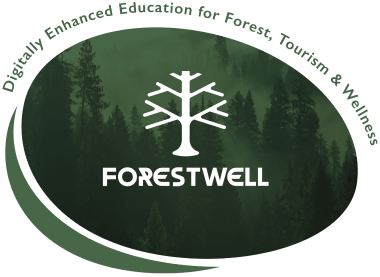Topic Progress..
In this section, you will learn about high-impact ForestWell regenerative marketing and campaigns and what they encompass in terms of promoting ForestWell products and experiences while cultivating a deep connection with your visitors and natural forest environments. It emphasises creating awareness, attracting target markets, and nurturing such relationships that prioritise sustainability, forest, and visitor well-being. These regenerative marketing practices will demonstrate how to focus on nurturing visitor preferences, building and enhancing your reputation, and creating long-term value for customers. It highlights existing business case studies and the positive characteristics of existing high-impact campaigns built on trust-based business models, sustainability, and imagination-driven campaigns. It addresses possible challenges such as messaging, different market themes, digitalization, and branding. Contrary to traditional marketing approaches focused solely on transactional volume, the demonstrated regenerative marketing strategies prioritise building deep trust and focus on long-term tourist and community relationships.
ForestWell regenerative marketing is a theoretical concept that involves the development and implementation of marketing strategies and campaigns to promote and communicate the value of ForestWell products and experiences. It focuses on creating awareness, attracting potential participants, and fostering a deep connection between individuals and the well-being benefits of immersing themselves in natural forest environments.
Becoming a regenerative marketing professional requires rethinking and building upon inspiration behavioural changes that are focused not only on sustainability but the whole ecosystem.
Regenerative marketing is defined as marketing practices which nurture communities and build local prosperity over the long term. The outcomes of regenerative marketing include value creation for customers, employees, and local communities.Regenerative marketing practices must – by definition – build community wealth.
Preliminary research findings from Italy suggest the following positive characteristics:
Some of the shortcomings of regenerative companies include:
The traditional “go-to-market” approach we’ve used for the past 100 years is about building a product and taking it to market based on a customer value-proposition. Because the business is built on the volume of its transactions, the business does not focus on long-term community relationships. In fact, it is often at odds with community aspirations and must play “nice” by being a good corporate citizen – via CSR and public relations.
Regenerative marketing, on the other hand, is all about deep trust. It begins (and ends) with the company’s relationship with the local community. In fact, the business may even be community-owned. This creates a new domain for value creation ignored by traditional b-school thinking: “community value creation.” (Source The Marketing Journal)
Here are the key elements and theoretical considerations of ForestWell’s regenerative marketing:
Understand Regenerative Principles: Gain a deep understanding of regenerative principles and how they apply to your forest product or service. Familiarize yourself with concepts like sustainability, biodiversity conservation, and community well-being.
Identify Your Unique Selling Proposition (USP): Determine what sets your forest product or service apart. Identify the regenerative aspects that make your offering special, such as sustainable sourcing, biodiversity conservation, or community engagement.
Know Your Target Audience: Conduct market research to understand the needs, preferences, and values of your target audience. Know what motivates them and how they connect with regenerative concepts.
Craft a Compelling Story: Create a narrative that tells the story of your forest product or service. Highlight the journey from sourcing or creation to the positive impacts it has on the forest ecosystem, local communities, and the planet.
Transparency and Authenticity: Be transparent and authentic in your marketing. Clearly communicate your regenerative practices and the steps you take to minimize negative impacts and maximize positive ones.
Visual Identity and Branding: Design a visual identity and branding that reflect the regenerative values of your product or service. Use imagery and colours that evoke nature, sustainability, and renewal.
Educational Content: Develop educational content that informs your audience about the forest ecosystem and the importance of regeneration. Share information about how your product or service contributes to the well-being of the forest.
Highlight Positive Impact: Emphasize the specific positive impact of your product or service. Use quantifiable metrics if possible, such as the number of trees planted, carbon sequestration, or support for local communities.
Community Engagement: Showcase your commitment to community engagement. Highlight partnerships with local communities and how your business supports their well-being and development.
Sustainable Practices: Detail the sustainable and regenerative practices you employ in your business operations. Explain how you reduce waste, conserve resources, and support circular economy principles.
Certifications and Accreditations: If applicable, feature any certifications or accreditations that validate your regenerative practices. Examples include Forest Stewardship Council (FSC) certification or eco-labels.
Social Media and Online Presence: Use your online presence, including social media, website, and blogs, to consistently communicate your regenerative values and stories. Engage with your audience and respond to questions or feedback.
Tip: Example of using images to convey your visual identity. Don’t forget to have awesome photos up on not just your social media channels but also your website, business, and marketing collateral, posters and digital media or videos.
Collaborate with Like-Minded Organisations: Collaborate with organisations or initiatives that share your regenerative values. Highlight these partnerships in your marketing efforts to amplify your impact.
Measure and Report Impact: Regularly measure and report on the positive impact of your forest product or service. Share this data with your audience to demonstrate your commitment to transparency and accountability.
Interactive Experiences: Create interactive experiences that allow customers to engage with your regenerative mission. This could include tree-planting events, virtual forest tours, or educational workshops.
Feedback and Improvement: Encourage feedback from customers and stakeholders. Use this input to continually refine your marketing strategies and enhance the regenerative aspects of your product or service.
Long-Term Commitment: Emphasise your long-term commitment to regenerative practices and the ongoing positive impact you aim to achieve.
ForestWell Regenerative Marketing Is Very Different to Sustainable Tourism. Regenerative tourism is a holistic and mindful approach that aligns with the values and principles of well-being and nature immersion. It aims to inspire individuals to seek the transformative experiences that forests can offer, ultimately leading to improved well-being and a deeper connection with nature.
